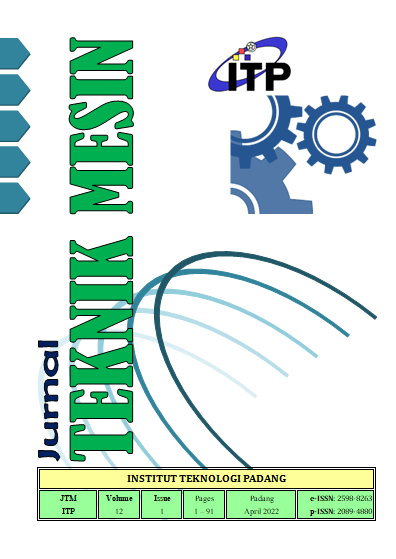Failure Analysis of the Screw Press Machine
DOI:
https://doi.org/10.21063/jtm.2022.v12.i1.72-81Kata Kunci:
press screw, press machine, failure, compression cycle, remaining lifeAbstrak
In this paper, an analysis of the mechanical components of the Screw Press Machine is carried out in the form of an analysis of the design of mechanical components, maintenance cycles and remaining life. From the design analysis of mechanical components, it is known that the stresses that occur in the screw are in the form of nominal shear stresses of 18.18 N/mm², axial stresses of -10.41 N/mm², bending stresses of 54.66 N/mm², and shear stresses acting on the base screw of 65.41 N/mm². The number of press cycles that occur in one hour is 121 cycles. Number in the press cycle that occurs in the worm screw press is 2.625x105 cycles. In field conditions with pressure fluctuating between 30-40 bars, the life time of using a worm screw press is around 2169.43 hours.
Referensi
-[1] A. Firmansyah & A. Roosmawarni, 2019, Kewirausahaan (Dasar dan Konsep),Surabaya: Qiara Media.
E. Ewaldo, 2015, “Analisis ekspor minyak kelapa sawit di Indonesia”, e-Jurnal Perdagangan, Industri dan Moneter, Vol. 3. No.1, pp. 10-15.
Direktorat Jenderal Perkebunan Kementerian Pertanian, 2018, Statistik Perkebunan Indonesia komoditas Kelapa Sawit 2017-2019, Jakarta: Kementerian Pertanian. http://ditjenbun.pertanian.go.id/?publikasi=buku-statistik-kelapa-sawit-palm-oil-2011-2013.
A.A. Rais, “Analisis Faktor-Faktor Yang Mempengaruhi Ekspor Minyak Kelapa Sawit Indonesia”, https://dspace.uii.ac.id/handle/123456789/33098
K.O. Purnama, D. Setyaningsih, E. Hambali & D. Taniwiryono ,2020, “Processing, Characteristics, and Potential Application of Red Palm Oil - A review,” International Journal of Oil Palm, Vol. 3, No. 2, pp. 40–55. https://doi.org/10.35876/ijop.v3i2.47.
D.I. Widiputri, A. Jayaratana, E.H. Legowo, 2020, ”Improving Methodology of Squalene Extraction from Palm Fatty Acid Distillate (PFAD) through Enhanced Pre-Treatment Process,” J. Functional Food. & Nutraceutical, Vol. 1, No. 2, pp.39-48.
J.D. Bala, J. Lalung & N. Ismail, 2014, “Palm Oil Mill Effluent (POME) Treatment ‘‘Microbial Communities in an Anaerobic Digester’’: A Review,” International Journal of Scientific and Research Publications, Vol. 4, No. 6, pp. 1-24, June 2014, ISSN 2250-3153.
M. Marimin, 2020, “Production planning of crude palm oil: a study case at X Co.,” IOP Conference Series Earth and Environmental Science 472(1):012047, DOI:10.1088/1755-1315/472/1/012047.
R.A. Ilyas, S.M. Sapuan, M.S. Ibrahim, M.H. Wondi, M.N.F. Norrrahim, M.M. Harussani, H.A. Aisyah, M.A. Jenol, Z.N. Hayawin, M.S.N. Atikah, R. Ibrahim, S.O.A. SaifulAzry, C.S. Hassan & N.I.N. Haris, “Introduction to oil palm biomass,” Oil Palm Biomass for Composite Panels (Fundamentals, Processing, and Applications), 2022, Pages 3-38.
T. Hasballah & E.W.B. Siahaan, 2018, “Pengaruh Tekanan Screw Press Pada Proses Pengepresan Daging Buah Menjadi Crude Palm Oil,” JURNAL DARMA AGUNG, Vol. XXVI, N. 1,pp. 722-729.
Unduhan
Diterbitkan
Terbitan
Bagian
Lisensi
Hak Cipta (c) 2022 Dedi Wardianto

Artikel ini berlisensiCreative Commons Attribution-NonCommercial-ShareAlike 4.0 International License.


